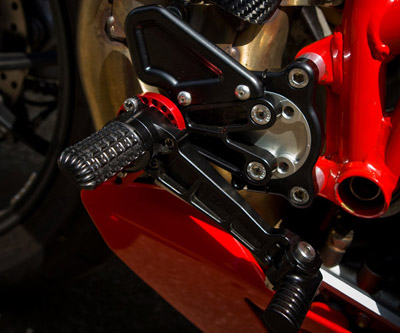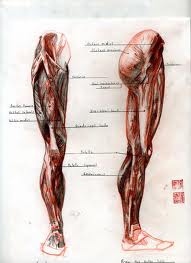
The Foot pegs
You are probably wondering what on earth I am going to have to say abut the foot pegs. I mean in what way are they a control? Now this is one of those moments when being an old bastard pays dividends.
Back in the 80’s when bike frames were made of recycled rubber bands glued together, you learnt really quickly about the impact you could have on a bikes wobbly bits (the whole thing) but these days the frames and other parts are so good that it’s not until they are under extreme loads that you start to feel the difference. Trust me at full noise and full lean on a modern superbike it is a really hard time to learn how to use the pegs to load the frame and stop it wobbling!!!
But the pegs do a lot more than that. They are a very effective tool for controlling your motorcycle and you really need to learn how to use them.
Evolution and Natures shock absorbers
First lesson is that if you “sit” on your bike any weight will be at the highest point on the bike, second point is that for the bike to move up in response to any bump in the road it will need to move your weight up as well. In doing so it will “bounce” you up and cause your lovely stable position on the bike to be upset.
Now having become all friendly and knowledgeable around Newton’s Third law we all know what that means!!!!!
But even more importantly, modern bikes have tremendous power and drive to control and that unfortunately and again due to Newton’s third, means that they need quite stiff suspension so that the power doesn’t get it all a wobbling under drive. All this means that they are not as responsive to small bumps as they could be. Any sports bike rider knows that if you get a bumpy corner you have to slow down because of this right???? Wrong!!!!
Strangely enough if you move 100+Kg (or less if you are a wimp :-)… ok not as fat as me) off the seat and position it over the pegs, then small bumps will move the rear of the bike up instead of you. Also if you have the balls of your feet (just behind your toes) on the peg and are effectively squatting on them your legs will start to work as shock absorbers and keep your upper body from upsetting the balance of the bike.
Actually you legs, having undergone about a millions years more development than your Johnny come lately Ohlin’s shock absorber are amazingly effective as shock absorbers and can allow your bike to move around a lot and keep your body stable and able all the whilst.

So first use of the foot pegs you should know about is controlling the WORST handling part of the package, you the rider.
Turn Baby Turn
The second part you want to know about the foot pegs is their ability to turn your bike or more importantly to lean your motorbike.
Just as we have learned that turning your bike really is a matter of dialling in the correct lean, the pegs can help a lot with this.
A great exercise to try is riding along with the balls of your feet on the pegs. Raise you self up so that no weight is on the seat at all then move all your weight from one peg to the other (making sure you have removed all the weight from the light side i.e. foot lifted if you can).
You’ll quickly see that the bike wants to lean and therefore turn in the direction that the weight is being applied. Now you’ll also note that this is in no way as powerful as the concept of counter steering but effective all the same. Now imagine that you are in a corner and need to just tighten up the line a little.. or widen it even. Counter steering in this situation can be a little tricky as it is a very powerful control and you only want to adjust that line a little without bringing the whole Newton’s Third into play and causing a mid corner transition.
Pegs!!! They are the answer… and a really good one too boot!!! Pun intended !!!
The other benefit of this is that it moves the centre of gravity for the bike and therefore the centre of effort for the tyres lower down the frame and more inline with the traction surface… you get better grip in English!!!
The twist is not just a dance
The Third one is the twist, the loading of the frame. When a bike is moving about, having a rider yanking on handle bars, bumps hitting the front before the back and generally a bunch of forces that try to get the front moving dependently of the rear the frame has to be pretty strong to resist it all.
Modern frames are pretty strong and they are particularly strong in rotational or twisting forces, because these are the ones that really matter. These are the forces that pull wheels out of line and change critical axis’s.
But the forces that frames need to resist still bend them, because we are talking about LOTS of force. When this happens the frame moves a little and then like suspension gets harder and harder to move. The initial “twist” gets taken up so to speak.
Just like suspension, if you can induce this initial twist early and make sure that the frame is “held” under load until you are ready to enter your next “Transition” things will be a lot better than if you load and unload a frame in the middle of a corner.
Getting a lot of your weight onto the inside foot peg and in particular in a direction across the frame is a very good way of doing this. If you look at pictures of races they almost always have their inside foot right on the ball and pushing sideways against the peg whilst their outside foot is often flat or even slightly off the peg, all their weight is being used to load up that inside peg and twist that frame.
Fortunately this is for two reasons, get the twist and help the bike lean over into the turn… holding it onto a tight line. BTW, this is why a racer after an injury often can’t hold that tight line, they just don’t have the strength or pain threshold to put enough pressure through the frame to hold it down and tight.
Once you learn your way around this you will see exactly what I mean if you put the pressure on the outside peg… The bike just will refuse to hold that tight line around the corner.
There is another reason why this works and that is the aid you give the bike in causing tread walk, that distortion of the tire against the road as it is rolling that causes the bike to over or under steer. YOu can see this if you hold a bike (with help) on an angle and put your weight onto the peg, the tires will distort.
if your wondering what goes into your tires take a look at – Dunlop racing tires



